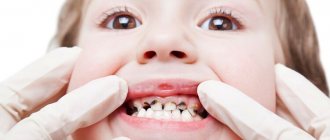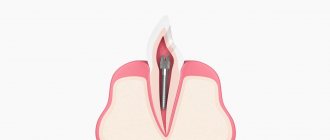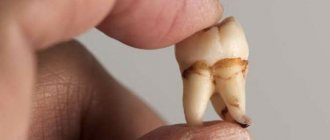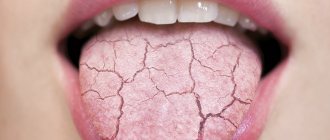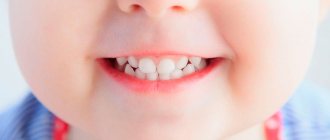If we proceed from the generally accepted canons of the formation of the dental row in a child, then by six months, maximum by 8 months, teeth should appear. However, in reality this does not always happen. Despite reaching the age of eight months, the baby does not experience teething.
Parents should not panic in such a situation, although the question of why the child has no teeth requires an immediate answer. Sometimes such a development of events is only a slight deviation from the norm, but often indicates a serious pathology.
Facts about teething
Teething is a complex physiological process that lasts for several years. During this period, the formation of tooth germs and their movement inside the jaw occurs. The process of teething is most often quite painful. There is a gradual change in the bite: a temporary (milk bite) changes to a permanent one. This is due to the development of bones in the child, in particular, with the growth of the skull bones. Also during this period, the formation of bone structures, soft tissues that surround the tooth, and the resorption of the roots of the milk units occurs to free up space for the permanent ones.
The first stage of tooth formation begins in the embryonic period. The complete completion of this process occurs with the eruption of wisdom teeth at approximately 25 years of age.
The period of active growth and weight gain continues
At nine months, your baby will still look like a baby—with a big head, chubby legs and arms, and an adorable belly. As he begins to move more and test his strength in standing and walking, the outline of the child's figure will begin to change.
According to Russian pediatricians, on average at nine months your baby will have:
- weight gain per month of 500 g, weight up to 8600-9000 g;
- height increase per month of 1.5 cm, height approximately 74 cm;
- head circumference - 44.5-45.5 cm;
- chest circumference - 46.5-47.5 cm.
When do the first teeth appear?
At the time of birth, the baby's teeth are in a state of formation inside the jaw bones. The bone contains a complete set of primary teeth at different stages of growth. The front incisors are the earliest to form and begin to emerge through the gums at six months of age. With the correct development of the child, dental units continue to erupt in pairs, i.e. one on each side. A full set of twenty primary teeth should appear in the first three years of a child's life.
How to speed up teething
Parents are often anxiously awaiting the appearance of their baby's teeth. Moreover, all the signs of eruption are already present, but the chewing organs still do not appear. How to be? Follow all recommendations according to regulations.
Before erupting, the tooth overcomes many obstacles. Bone tissue comes first; the path is paved by the dental crown. The mucous membrane becomes an obstacle.
To read: Tablets after tooth extraction
The process is more complicated due to the elasticity of the fabric. To promote teething, baby saliva contains enzymes that “melt” the mucous membrane. Saliva has antibacterial substances that help fight infection that occurs as teeth grow.
Parents will provide harmless, feasible help to the baby if they give him:
- solid food: carrots, dried bread, crackers,
- a rubber teething ring purchased at a pharmacy.
Parents must remember that there is no way to speed up teething. Preparations containing calcium will be useless for such a case.
They are successfully eliminated from the body; only a small portion is absorbed. Teething does not occur not because of calcium deficiency; the process itself is much more complex.
Do you feel nervous before visiting the dentist?YesNo
Dentistry does not have an exact answer to the question of what causes teeth to appear. The main assumption is the development of the baby tooth; its growth directly forces the tooth to move. Of course, growth requires the presence of microelements, but also appropriate time for cell division.
How to determine the delay in teething
If a child is 1.5 years old and still does not have a single tooth, then this is a serious reason to seek advice from a dental clinic.
The normal period for the appearance of the first teeth in the oral cavity is considered to be from 4 to 16 months, subsequent teeth appear gradually after the first.
Permanent teeth begin to grow by the age of 6-7 years.
A slight discrepancy with the established deadlines is not a reason to sound the alarm; you should worry if the child has a complete absence of teeth.
No teeth at one year of age
Why does a child’s teeth not grow after a year of life?
- Hereditary predisposition.
- Unsuitable climate.
- Poor quality of food and water.
- Diseases and infections.
- Vitamin and calcium deficiency.
To dispel or confirm suspicions, you need to take your baby for examination to a therapist and dentist. To determine the causes of delayed jaw development, blood tests, urine tests, ultrasound examinations of organs, and testing of thyroid function may be necessary. To exclude edentia (lack of teeth) from the diagnostic field, fluoroscopy is performed.
Types of delay in teething
A discrepancy from the average statistical time of more than six months in the eruption of baby teeth is considered a delay.
The delay from the average time in the appearance of permanent teeth should not exceed a year. There are two types of late eruption.
- Late formation of dental follicle. In such a situation, the relationship between the development of the tooth and its appearance in the oral cavity is observed, but both processes proceed more slowly than expected.
- Late eruption. With this development, the tooth is fully formed, its root grows, but the dental unit cannot erupt. Fully formed teeth remain in the bone – impacted. They may be completely under the gum or partially visible from under it.
Before worrying about delayed eruption, it is necessary to diagnose the presence of a tooth germ in the bone. To do this, a panoramic photograph is taken, which makes it possible to distinguish the complete absence of a rudiment from a delay in formation.
Reasons for retention
Most often, the reason for the development of retention is associated with the incorrect location of neighboring teeth, which become an obstacle to the eruption of retention teeth. In other cases, the problem may be due to too dense bone or gum tissue.
Other factors influencing the development of pathology include the following phenomena:
- supernumerary (abnormally large number of teeth),
- diseases of internal organs, which leads to disruption of the full development of the entire skeletal system,
- loss of baby teeth at too early an age,
- genetic predisposition.
Reasons for delay in teething
There can be many reasons for delays in teething.
- Hereditary factor. If parents cut teeth later than other children, then this symptom may also be observed in their children.
- Prematurity or low birth weight of the baby.
- Diseases of the expectant mother during pregnancy, injuries during childbirth, as well as illnesses of the child in the first few months after birth.
The factors listed above most influence the timing of eruption, as well as the quality of formation of dental units.
Other reasons include:
- violations in the child’s diet;
- lack of certain vitamins and minerals;
- hypothyroidism;
- rickets and its consequences.
It should also be taken into account that girls are ahead of boys in development, and, therefore, their teeth appear earlier.
What to do to ensure that your child’s teeth develop normally
Before and during pregnancy:
- Maintain dental health.
- Eat well and varied.
- Eat more foods high in calcium.
- Do not smoke or drink alcohol.
- Walk in the fresh air more often to maintain a healthy level of hemoglobin in the blood.
- Treat in strict accordance with medical recommendations.
After childbirth:
- provide the child with a rich and balanced diet;
- monitor the baby’s hygiene;
- walk in the fresh air to harden the child’s body;
- prevent infection and diseases of internal organs;
- Consult a doctor in a timely manner in case of painful syndromes.
What determines the timing?
The timing of the formation of both temporary and permanent dental units in children can be compared with certain phenomena.
- Floor. In girls, all teeth, except the first upper chewing one, erupt earlier than in boys.
- Jaws. Teeth appear faster on the lower jaw than on the upper jaw.
- Position of teeth. Molars and premolars most often erupt with a delay.
- Bite. In primary dentition, delay occurs much less frequently than in permanent dentition.
- Population. Scientists have found that people living in different countries have different timing for the appearance of teeth. For example, among Europeans, delayed eruption is a fairly common occurrence.
- Climatic conditions. In warm climates, teeth erupt faster than in cold climates.
- Level of urbanization. City residents develop teeth faster than those in rural areas.
- Evolution. Recent generations are more likely to encounter anomalies in the eruption of wisdom teeth and canines in the upper jaw. Scientists explain this phenomenon with the evolution of humans as a species, and with the lack of space due to a decrease in the overall size of the jaw.
What complementary foods does a 9 month old baby eat?
The diet of a 9-month-old baby is already quite varied. Your baby can continue to receive breast milk and/or formula and complementary foods. The products will no longer include only cereals, vegetables, meat and dairy products, but also bread, butter and vegetable oil, and fish. And in order not to harm the baby, when switching to a “common table”, mothers adhere to the scheme for introducing complementary foods
— the table contains recommended foods for feeding and portion sizes per day depending on the child’s age. Complementary feeding introduced in a timely manner will become the basis for proper nutrition and good appetite even for small children.
What else should you pay attention to?
If you are no longer breastfeeding or your baby has been bottle-fed since birth, we advise you not to rush into introducing whole cow's milk and the milk of other animals. Let only baby formula remain in the diet for now, since it is adapted to the physiological characteristics of the digestion of babies, which means it is easier to digest.
Among MAMAKO® baby food there are mixtures for children in the second half of life, and complementary feeding products for a baby at nine months (including for nutrition with a tendency to allergies). Buckwheat and corn porridge, 5-grain porridge and cream soups of pumpkin and spinach with goat's milk, fruit puree with goat's curd - all these are complementary feeding options allowed by pediatricians for children under one year old.
From 6 months to 2 years, young children are especially open to new taste sensations. And mother can help her baby develop them. How? Try offering your child multi-ingredient cereals. For example, buckwheat porridge with apple and carrots. Many kids are very curious about new and varied tastes and eat such treats with pleasure.
How many teeth should a child have at 10 months?
There are certain dates for the appearance of the first teeth, based on which pediatricians monitor the overall development of the baby. However, parents should remember that such standards are approximate. Some babies are already born with teeth, while others have their first chewing organ erupt after a year.
When parents are interested in how many teeth a child should have at 10 months, a special formula can be used. It is quite simple and allows you to determine the number of teeth for children up to two years old. According to the formula, the number of cloves should correspond to the number of months of the baby’s life minus four. If the child is 10 months old, then 10, 4 = 6, about 6 teeth he should have. This is according to approximate standards.
Typically, a ten-month-old child will have at least two teeth. They are often represented by the lower central incisors, but there are exceptions. When baby teeth erupt late, their order is not always correct.
First, one incisor at the top and bottom or two main upper incisors may appear. While some people already have 4 upper and 4 lower incisors by this age.
Symptoms of disorders
There are special formulas that show how to correlate the age of a child with the number of chewing organs cut through him and understand whether everything is going well, but we are not going to overload the reader by immediately getting to the point.
The concept of a norm in this case is very flexible, because in different sources we will find different terms. Some pediatricians insist that the eruption of the first teeth later than the eighth month of life is a pathology, others argue that this is quite normal, but it is impossible to separate pathology from the norm without studying a specific patient.
Even if there is a delay in dental development, if the child looks healthy and no systemic pathologies are detected, then parents can calm down and wait a little until the teeth begin to cut.
If the child is sick, then this may be a problem with his teeth. Early eruption, for example, can be both an individual characteristic of the body and evidence of incorrect functioning of the endocrine glands.
Examination and treatment
If a child has no teeth at 10–12 months, the pediatrician may prescribe an examination to determine the reasons for the delay. A panoramic x-ray shows whether there are baby tooth buds in the child's jaw. In case of partial edentia, specific treatment is prescribed to allow the embryos of permanent teeth to develop correctly. To ensure that the jaw is formed correctly and food is chewed efficiently, special removable dentures are made to compensate for missing baby teeth for a 3-year-old child.
The doctor may prescribe an ultrasound scan of the abdominal organs, blood tests, stool tests, urine tests of the child and others, if necessary. Vitamins and minerals are prescribed to strengthen the immune system, primarily vitamin D and calcium. The child should spend as much time as possible outdoors. He is given ring toys as a stimulant. A light massage of the gums with a clean finger is helpful.
Parents should be alerted if the incisors erupt too early, before 3 months. In some cases, this may indicate disorders in the endocrine system, but more often than not, early teething in children is an individual feature.
Before appearing from the outside, the incisor passes through the bone tissue surrounding it, and then through the mucous membrane of the gums. Do I need help with teething? Trying to speed up the process of its appearance with a piece of sugar, a spoon or other objects, you can damage the gums and introduce an infection into it.
According to a good ancient tradition, the one who discovers the child’s first tooth gives him a silver spoon. It is believed that she will bring him health and wealth. She can lightly tap the tooth and make sure that it has erupted and all anxious expectations are left behind.
When should you see a doctor?
Teething causes a lot of discomfort for the baby. This does not require medical attention. But there are situations when you cannot do without the help of a doctor. You should contact him in the following cases:
- Painful cough.
- The temperature does not subside for a long time.
- There is mucus and blood in the stool.
- Diarrhea
- and purulent nasal discharge.
- Constipation.
- Mouth ulcers.
- Unnatural color of the shoots.
Symptoms from teething hide the manifestation of diseases, for example, ARVI or infectious diseases. It is important to consult a doctor if negative symptoms occur. Exercise caution in such cases rather than regret later what you didn’t do.
How a dentist can help
If you are not ready to wait a year, seek help from a good pediatric dentist. The specialist will take an X-ray of the jaw to ensure the presence of tooth buds. If everything is fine, all you have to do is calmly wait for the process to begin - gum enlargement and increased salivation. Now it's time to help the baby:
- a ring stimulator will moderate itching, reduce discomfort and speed up teething;
- You can gently massage your child’s gums with a clean finger or a small spoon;
- stimulates tooth growth and fortified complementary foods - healthy juices and purees. While there are no teeth, solid complementary foods cannot be introduced.
This is interesting: Aphthous stomatitis in children: signs, causes and methods of treatment
If your health is fine
The timing of eruption depends on heredity, including grandparents, and on external factors. It is believed that in hot climates, teeth appear earlier, as early as 4 months. When a child is healthy and his development corresponds to his age, but there are still no teeth, although they should already appear in accordance with average standards, this causes concern among parents. Modern doctors indicate only approximate dates for the sequence of growth of the first teeth. The standard teething pattern looks like this: from 5–6 months - on each jaw there are 2 central incisors (first from below, then from above), from 8 months - lateral incisors, by the year the child has only 8 teeth. They are known to appear in pairs and alternately on both sides.
What to do if a child has only grown one tooth and there are no signs of a second one? You need to know that the sequence of teething may be different and this is not considered an anomaly. There are many options for their appearance. At seven months they can erupt 2 - from below, then 1 - from above, then the third and fourth - in the bottom row, and only after them the missing top one.
Many mothers tend to associate the whims of a 3-4 month old child, poor sleep or appetite with the imminent appearance of the first incisors. There is no doubt left if the baby also puts everything into his mouth and drools profusely. Sometimes it seems to mothers that the gums are already red; they look into the child’s mouth in the hope of seeing that swollen white ball from which the long-awaited tooth is about to emerge. But days and weeks pass, the child is already 7 months old, and there are no teeth? No need to panic.
If the baby’s health is fine, you just need to wait, especially since all the dates are individual and there may be deviations in one direction or another for six months. Some children have their first incisors at 4 months, while other babies can already walk by the time they begin to emerge.
Causes of pathology
So, let's imagine for a moment that the eruption of the first teeth after the eighth month of life is truly a pathology. What could be the reason for this phenomenon, when a child has no teeth at one year or at 10-11 months?
Poor nutrition, lack of necessary substances for the development of teeth in the body. In such a situation, parents need to reconsider their child’s diet and add more foods containing minerals like Calcium, Magnesium, and carbonates.- Presence of gastrointestinal diseases. The chewing organs are connected to the entire digestive system, and they cannot develop independently of it.
- Rickets. Rickets occurs when there is a lack of vitamin D in the child’s diet or metabolic disorders.
- Disturbances in the functioning of the hypothalamic-pituitary system, which is responsible for all processes in our body.
- Presence of genetic abnormalities.
Causes of eruption disorders
As we noted earlier, the formation of teeth and their further formation occur in the early stages of pregnancy. Therefore, a common cause of pathologies are disturbances in the development of the fetus in the first 4 weeks of development or diseases suffered by the mother during pregnancy. There is probably no need to say that the first trimester is key and most important, because at this time all the systems of the future person are laid.
Diseases that can cause incorrect development of teeth include the following:
- rubella;
- congenital syphilis;
- measles and other dangerous diseases.
Bad habits of the mother and her environment negatively affect the development of the fetus: smoking (active and passive), drinking alcohol, taking medications prohibited for use by pregnant women, and so on.
There is no denying that hereditary factors and unique characteristics of the body significantly influence the eruption of baby teeth.
Prevention of pathologies of eruption of baby teeth in children
It is impossible to control or influence such processes.
Dental buds are formed even before the baby is born, so after his birth it is difficult to change anything. During pregnancy, a woman should monitor her health, in case of illness, immediately consult a doctor, not self-medicate and not advance the disease. It is important to take vitamins, as they have a beneficial effect on the condition of the expectant mother and child.
After birth, parents are obliged to monitor the baby’s condition - take care of his health, provide complete and proper nutrition. This will affect not only the condition of the teeth, but also the overall development of the child.
